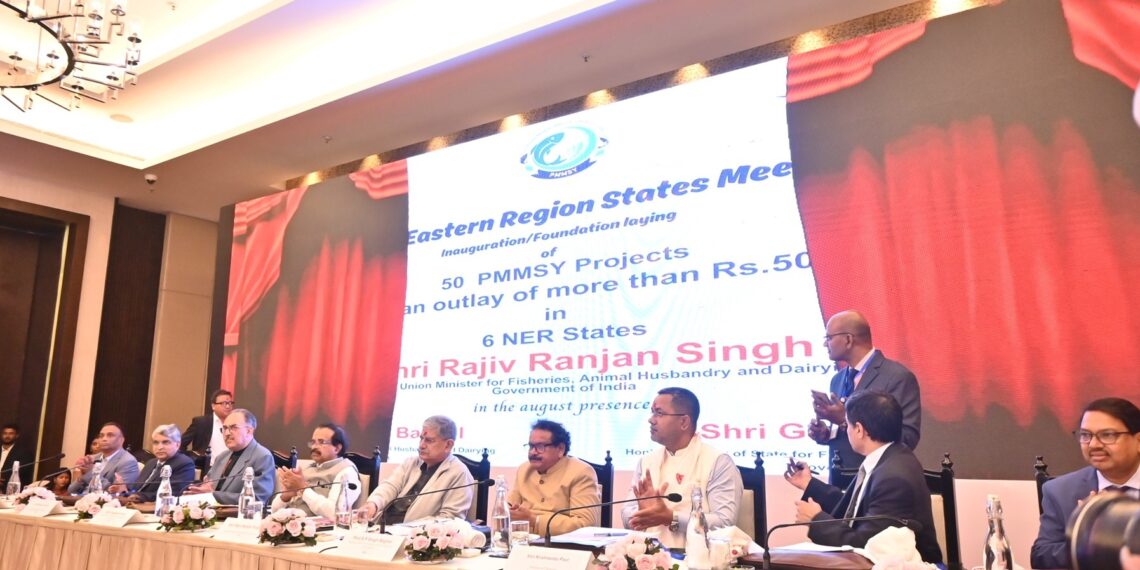Guwahati: Meghalaya’s fisheries sector is on the cusp of a transformative phase, with the Centre’s decision to promote recreational fisheries in the East Khasi Hills District.
Union Minister Rajiv Ranjan Singh inaugurated and laid the foundation for 50 fisheries development projects across the Northeast, with a total investment of Rs. 50 crore under the Pradhan Mantri Matsya Sampada Yojana (PMMSY).
This initiative, launched during the Northeastern Region States Meet organized by the Department of Fisheries, underlines the government’s unwavering commitment to promoting sustainable aquaculture practices and improving livelihoods in the region.
The total project allocation of Rs. 50 crore includes Rs. 38.63 crore from the central government, ensuring robust financial support for the region’s growth.
A significant portion of the funds will be directed toward Meghalaya, where Rs. 50 lakh is allocated for fisheries development projects.
The central share amounts to Rs. 27 lakh, with Rs. 20 lakh contributed by beneficiaries.
The primary focus of the initiatives in the state is on recreational fisheries in the East Khasi Hills District, strategically located in a popular tourist area.
This initiative is expected to draw more visitors to the region, generate local employment opportunities, and enhance the region’s tourism appeal.
Across the Northeast, various projects are set to enhance the fisheries industry, providing a much-needed boost to local economies.
In Assam, an Integrated Aqua Park in Darrang District will produce 150 metric tonnes of fish annually, generating Rs. 10-15 crore in revenue and creating up to 2,000 jobs.
Furthermore, a Large Fish Feed Plant in Kamrup District will produce 20,000 metric tonnes of feed annually, while hatcheries across the state will collectively aim to produce 50 million spawns annually, further enhancing the state’s aquaculture productivity.
Manipur is set to benefit from the establishment of ice plants and cold storage units in Thoubal and Imphal districts, which will reduce post-harvest losses and preserve fish quality.
Additionally, hatcheries focusing on locally significant fish species will play a crucial role in conserving biodiversity and boosting fish production.
In Nagaland, the construction of freshwater finfish hatcheries in Mokokchung and Kiphire districts will increase production capacity by 21 million fry annually, supporting the growth of local aquaculture and creating opportunities for tribal communities.
Similarly, Tripura will see the development of ornamental fish-rearing units and finfish hatcheries, utilising the region’s indigenous fish resources to promote ornamental fish farming and generate local employment.
The Northeastern Region (NER) is seen as a key player in India’s vision for self-sufficiency in fisheries, owing to its rich aquatic biodiversity and abundant freshwater resources.
Through flagship schemes like the Blue Revolution, the Fisheries and Aquaculture Infrastructure Development Fund (FIDF), and PMMSY, the central government has invested Rs. 2,114 crore into fisheries infrastructure, productivity improvements, and sustainable practices.
ALSO READ: China reaffirms plan for world’s largest dam on Brahmaputra, assures no harm to India or Bangladesh
This investment has already yielded impressive results, with inland fish production in the NER growing from 4.03 lakh tonnes in 2014-15 to 6.41 lakh tonnes in 2023-24, representing a 5% annual growth rate.
To further drive growth in the region, the Department of Fisheries (DoF) has made the NER a priority, introducing modern aquaculture parks, hatcheries, and fish processing units.
Innovative technologies such as Biofloc systems and Recirculatory Aquaculture Systems (RAS) are also being implemented to boost productivity and market access for fish farmers.
“The fisheries and aquaculture sector is not just a source of livelihood, but a catalyst for economic growth in the NER. With strategic investments and sustainable practices, the region is poised to become a major hub of progress,” the government emphasised.
These initiatives exemplify the Centre’s commitment to inclusive development, ensuring that the NER’s vast potential contributes significantly to India’s overall economic growth and ecological sustainability.















